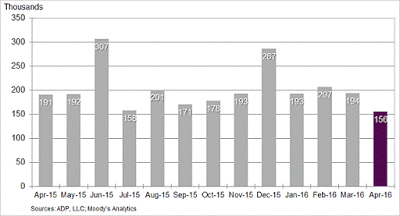The private sector added 156,000 jobs in April, according to the Automatic Data Processing (ADP) report, ahead of the Bureau of Labor Statistics (BLS) more comprehensive release this Friday. As the graph shows there is a slowdown form last month. This adds to weak manufacturing growth,and a smaller trade deficit, resulting from lower imports, that is, a slower economy. I still think a recession might not be in the immediate horizon. However, the data seem to indicate, as I said before, that there are good domestic reasons for Yellen not to hike the rate of interest.By the way, not surprisingly labor productivity has been weak, and according to the BLS it "decreased at a 1.0 percent annual rate during the first quarter of 2016... From the first quarter of 2015 to the first quarter of 2016, productivity increased 0.6 percent." This is sometimes reported still by suggesting that "low productivity [is] a puzzle to economists." It shouldn't be a puzzle, of course. Low productivity is the result of low growth. And that is the result of a contractionary fiscal stance, in an economy with too much inequality, and slow growing wages.
Topics:
Matias Vernengo considers the following as important: BLS, Employment, recession, Slow recovery, Yellen
This could be interesting, too:
Ken Houghton writes Just Learn to Code
Matias Vernengo writes Elon Musk (& Vivek Ramaswamy) on hardship, because he knows so much about it
NewDealdemocrat writes What to look for if housing construction does forecast a recession
Merijn T. Knibbe writes Employment growth in Europe. Stark differences.
This adds to weak manufacturing growth,and a smaller trade deficit, resulting from lower imports, that is, a slower economy. I still think a recession might not be in the immediate horizon. However, the data seem to indicate, as I said before, that there are good domestic reasons for Yellen not to hike the rate of interest.
By the way, not surprisingly labor productivity has been weak, and according to the BLS it "decreased at a 1.0 percent annual rate during the first quarter of 2016... From the first quarter of 2015 to the first quarter of 2016, productivity increased 0.6 percent." This is sometimes reported still by suggesting that "low productivity [is] a puzzle to economists." It shouldn't be a puzzle, of course. Low productivity is the result of low growth. And that is the result of a contractionary fiscal stance, in an economy with too much inequality, and slow growing wages.

